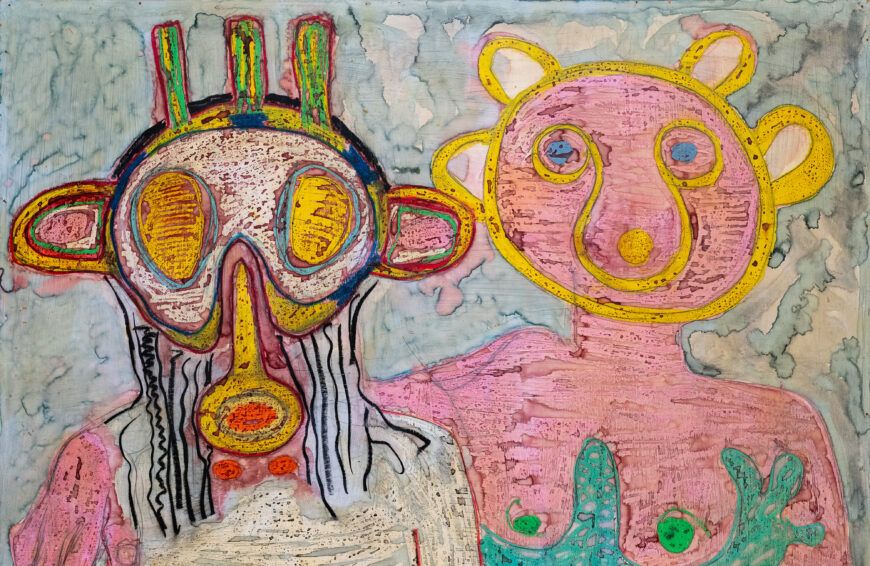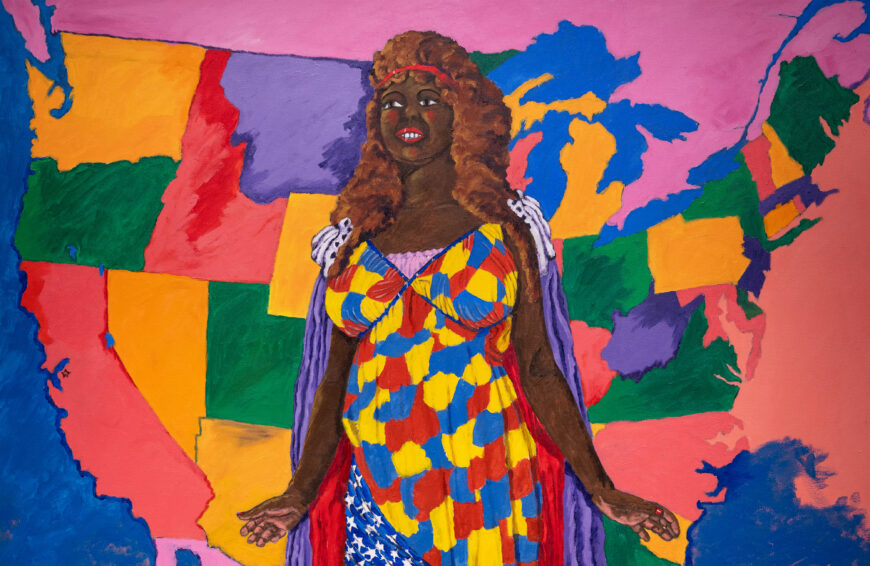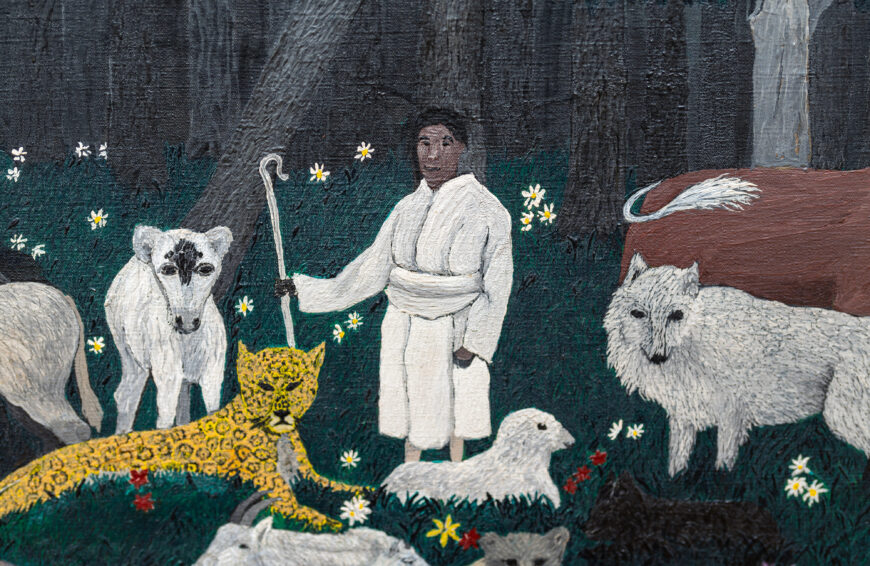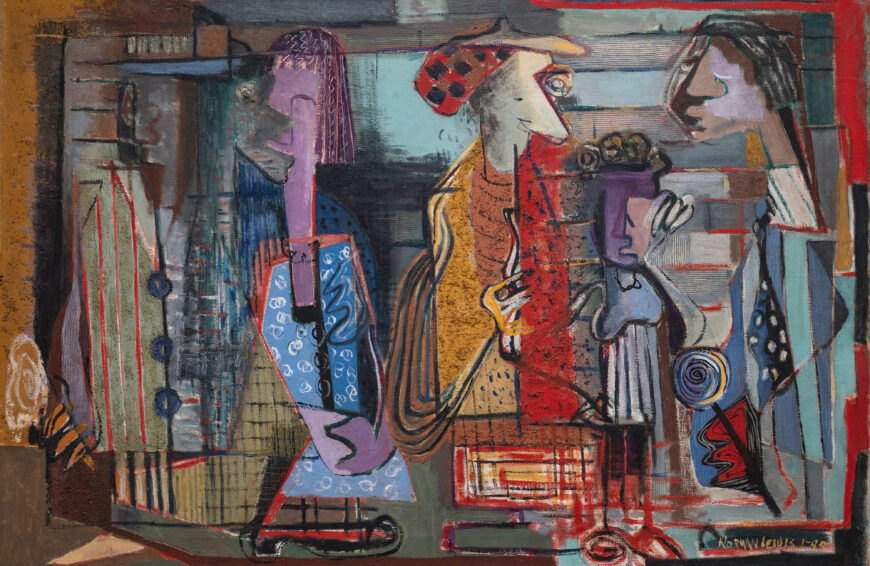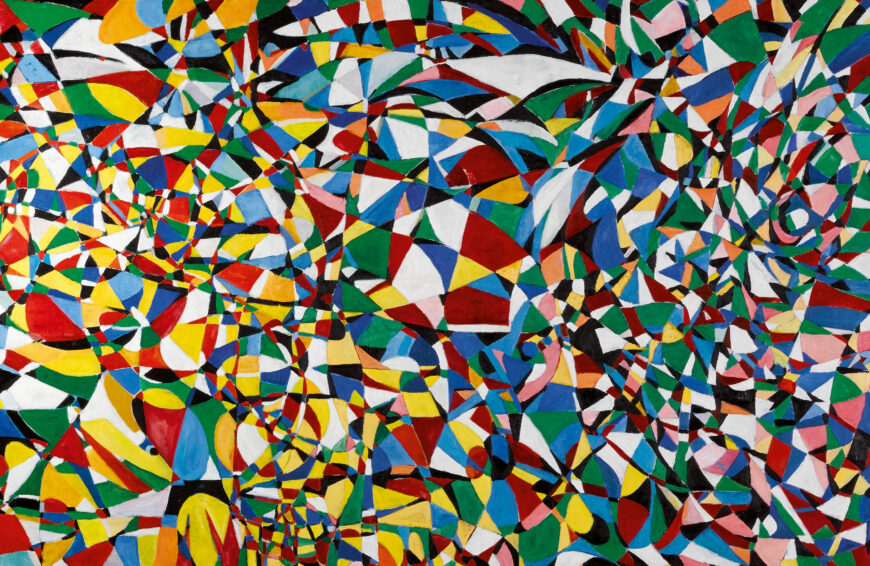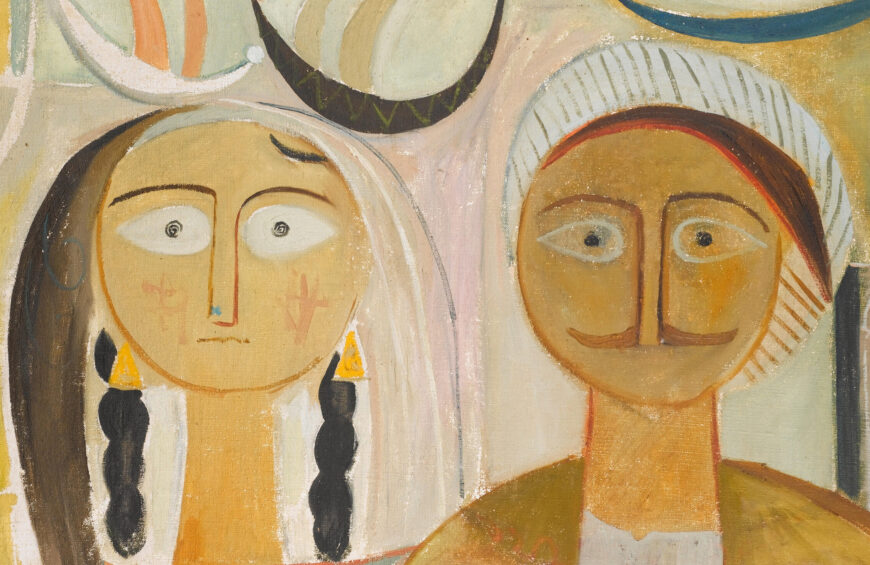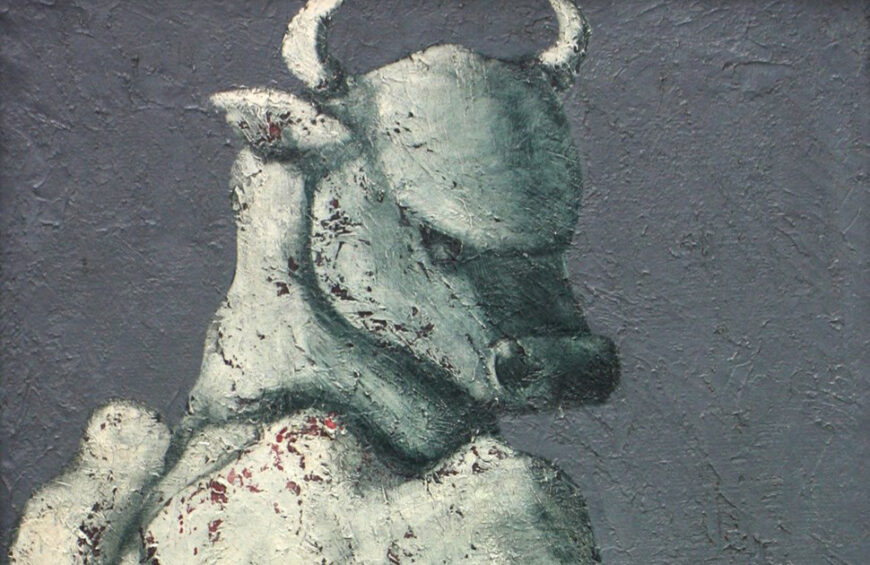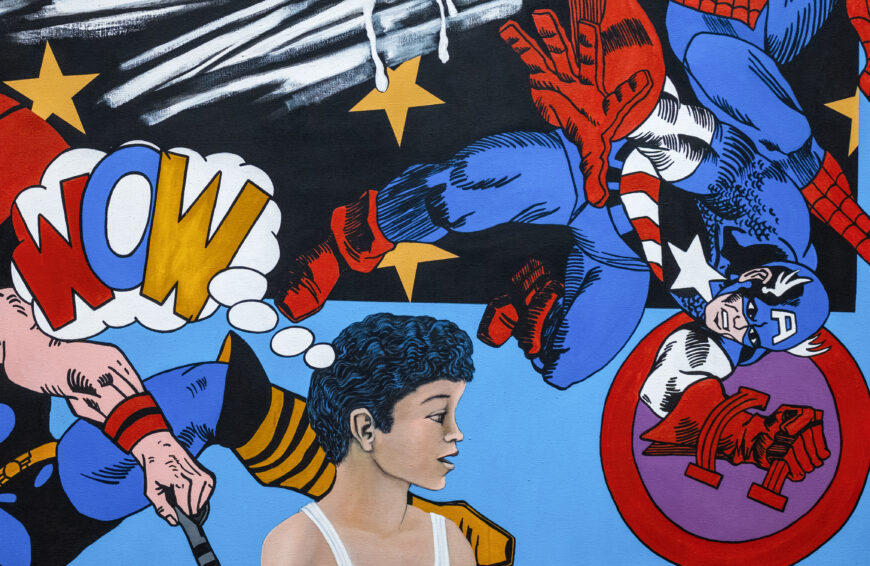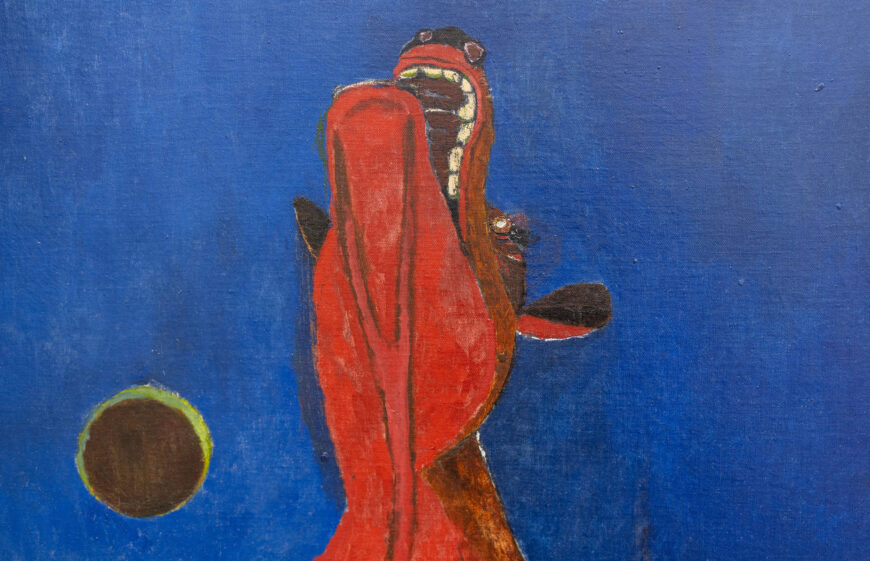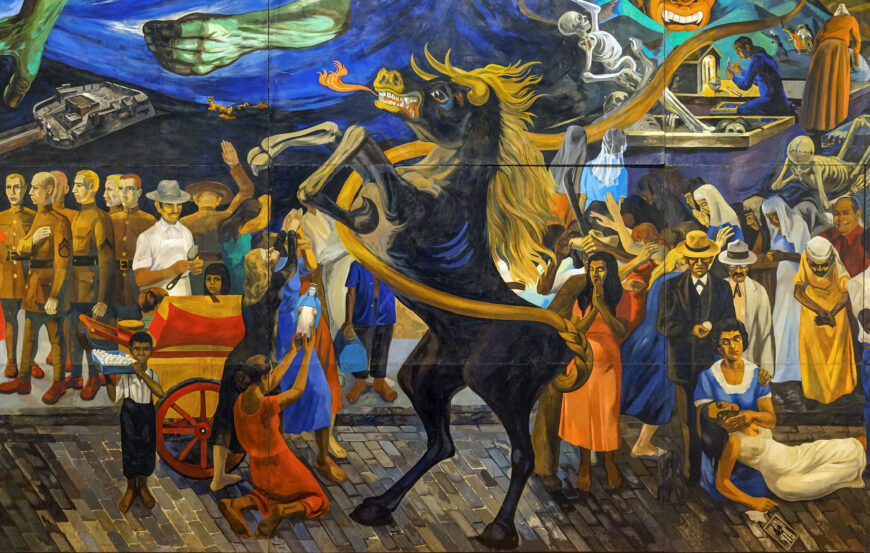The organic forms and radical abstraction of Krasner’s painting makes her canvas come alive.
Lee Krasner, Re-Echo, 1957, oil on canvas, 149.9 x 147.3 cm (Art Bridges) © Pollock-Krasner Foundation. Speakers: Wendy Earle, Curator, Akron Art Museum, and Steven Zucker
0:00:05.4 Steven Zucker: We’re in the Akron Art Museum in Akron, Ohio, looking at one of the most important paintings by an American artist of the mid-20th century. This is Lee Krasner’s Re-Echo, painted in 1957.
0:00:18.9 Wendy Earle: One of the things that I love about this painting is that when you’re walking into the gallery, you can see it, and it’s so obviously abstract. But as you get closer, it almost feels like there are figures in it. But then you get even closer and it becomes abstract again.
0:00:34.7 Steven Zucker: The canvas is square, but it feels vertical. There are these four or five or six or seven or twelve bodies or forms that seem to have heads. But wait, maybe they’re buds, maybe they’re tendrils. There’s something organic. They might be human, they might be plants. We’re not quite sure.
0:00:55.3 Wendy Earle: Nothing is ever a perfect circle. It is very natural, very organic. And so much of it is bare canvas.
0:01:03.0 Steven Zucker: The painting is not thick. The paint doesn’t really sit over the canvas. It’s all painted with a kind of thin wash. It’s as if she took her oil paints and had really thinned them in turpentine and then applied them. And she applied them with these seemingly quick, almost calligraphic strokes. So the surface is incredibly activated. And yet at the same time, the colors of the palette are soothing. They’re pinks and beige and earth tones with sharp green. And it fits perfectly with the title of the series of which this is a part, which is the Earth Green series. Her art always seemed to be rooted in the organic, in the power of nature. Lee Krasner was in Paris until she got word that her husband, the artist Jackson Pollock, had killed himself when he crashed his car into a tree. She immediately returned to New York. She had for many years been painting in a small extra bedroom upstairs in their house in Springs in East Hampton. But now she was able to move her studio into the barn where Jackson Pollock had made his very famous drip paintings. And now she had space. And this painting was one of the first canvases to come after these events.
0:02:14.9 Steven Zucker: And this painting, to me at least, feels like it’s about regeneration. It’s about growth. And while there’s no question that she had lived in the shadow of her husband, that she had made compromises in her life to benefit her husband for many years—in fact, they moved out of New York City because she was worried about his drinking and thought it might be lessened out on the east end of Long Island. So she had taken herself out of the active art world. She had been a student of Hans Hofmann. She was close to many of the most advanced artists in New York at this time. But now, in 1957, there seems to have been a kind of refocusing on her work. And we see the fruits of that experience here.
0:02:54.3 Wendy Earle: And certainly the title bears that as well. What is a Re-Echo? Is that a further distortion? Does that play into some of her grief? Does that play into some of the newfound openness she could have with these canvases and with her career in general? It certainly seems like she took this change and made space for herself in it. And so I think the Re-Echo can be a lot of things.
0:03:18.3 Steven Zucker: It does seem like a coming to terms with. There are, after all, drips in here. That’s Pollock’s signature. But there are also references to Hofmann. And most importantly, to the trajectory of her own style and her own career.
0:03:31.5 Wendy Earle: And I think she’s reclaiming the drips in a way. And putting her own voice into it.
0:03:36.6 Steven Zucker: There are places where her hand speeds, where her hand slows. There’s an incredibly complex play between the interweaving of space. How deep is the space that she’s constructing here? At some points, it seems flat. And yet it also seems as if we’re looking through some kind of foliage where things are both near and far. There are areas where paint tends to pool. There are areas where the paint is opaque. Areas where she almost produces a face that we can begin to grasp. But then it seems to dissolve. This is a painting by an artist who is tremendously aware of the traditions of art history.
0:04:15.2 Wendy Earle: And she had this great quote, “I like a canvas to breathe and be alive. Be alive is the point. And as the limitations are something called pigment and canvas, let’s see if I can do it.”
0:04:27.6 Steven Zucker: It might be hard to remember that in 1957, this painting was still really radical. That putting up a canvas that that didn’t depict something was asking a lot of the gallery viewer. But also trusting the gallery viewer, trusting their interpretations, their interaction with this work of art. There is a kind of freedom here. It is a conversation that also includes all of the people who see it.
0:04:53.4 Wendy Earle: There’s no artwork without an audience there to see it. What is the artist trying to say here? Can we know? Do we have an obligation to figure out what she is trying to say? Or do we just go with our own interpretations? How far does that relationship go between artist and viewer?
0:05:11.0 Steven Zucker: Well, in 1957, we would have said, this is Jackson Pollock’s wife. Now we can say that Jackson Pollock was Lee Krasner’s husband.



